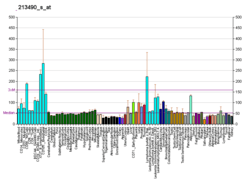MAP2K2
Dual specificity mitogen-activated protein kinase kinase 2 is an enzyme that in humans is encoded by the MAP2K2 gene.[5] It is more commonly known as MEK2, but has many alternative names including CFC4, MKK2, MAPKK2 and PRKMK2. [6]
Function
The protein encoded by this gene is a dual specificity protein kinase that belongs to the MAP kinase kinase family. This kinase is known to play a critical role in mitogen growth factor signal transduction. It phosphorylates and thus activates MAPK1/ERK2 and MAPK3/ERK1.
The activation of this kinase itself is dependent on the Ser/Thr phosphorylation by MAP kinase kinase kinases.
The inhibition or degradation of this kinase is found to be involved in the pathogenesis of Yersinia and anthrax.[7]
Interactions
MAP2K2 has been shown to interact with MAPK3[8][9][10] and ARAF.[11]
References
- 1 2 3 GRCh38: Ensembl release 89: ENSG00000126934 - Ensembl, May 2017
- 1 2 3 GRCm38: Ensembl release 89: ENSMUSG00000035027 - Ensembl, May 2017
- ↑ "Human PubMed Reference:".
- ↑ "Mouse PubMed Reference:".
- ↑ Zheng CF, Guan KL (Jun 1993). "Cloning and characterization of two distinct human extracellular signal-regulated kinase activator kinases, MEK1 and MEK2". J Biol Chem. 268 (15): 11435–9. PMID 8388392.
- ↑ "MAP2K2 mitogen-activated protein kinase kinase 2 [Homo sapiens (human)] - Gene - NCBI". www.ncbi.nlm.nih.gov. Retrieved 2015-10-16.
- ↑ "Entrez Gene: MAP2K2 mitogen-activated protein kinase kinase 2".
- ↑ Marti, A; Luo Z; Cunningham C; Ohta Y; Hartwig J; Stossel T P; Kyriakis J M; Avruch J (Jan 1997). "Actin-binding protein-280 binds the stress-activated protein kinase (SAPK) activator SEK-1 and is required for tumor necrosis factor-alpha activation of SAPK in melanoma cells". J. Biol. Chem. UNITED STATES. 272 (5): 2620–8. doi:10.1074/jbc.272.5.2620. ISSN 0021-9258. PMID 9006895.
- ↑ Butch, E R; Guan K L (Feb 1996). "Characterization of ERK1 activation site mutants and the effect on recognition by MEK1 and MEK2". J. Biol. Chem. UNITED STATES. 271 (8): 4230–5. doi:10.1074/jbc.271.8.4230. ISSN 0021-9258. PMID 8626767.
- ↑ Zheng, C F; Guan K L (Nov 1993). "Properties of MEKs, the kinases that phosphorylate and activate the extracellular signal-regulated kinases". J. Biol. Chem. UNITED STATES. 268 (32): 23933–9. ISSN 0021-9258. PMID 8226933.
- ↑ Yin, Xiang L; Chen She; Yan Jun; Hu Yun; Gu Jian X (Feb 2002). "Identification of interaction between MEK2 and A-Raf-1". Biochim. Biophys. Acta. Netherlands. 1589 (1): 71–6. doi:10.1016/S0167-4889(01)00188-4. ISSN 0006-3002. PMID 11909642.
Further reading
- Joseph AM, Kumar M, Mitra D (2005). "Nef: "necessary and enforcing factor" in HIV infection". Curr. HIV Res. 3 (1): 87–94. doi:10.2174/1570162052773013. PMID 15638726.
- Stove V, Verhasselt B (2006). "Modelling thymic HIV-1 Nef effects". Curr. HIV Res. 4 (1): 57–64. doi:10.2174/157016206775197583. PMID 16454711.
- Charest DL, Mordret G, Harder KW, et al. (1993). "Molecular cloning, expression, and characterization of the human mitogen-activated protein kinase p44erk1". Mol. Cell. Biol. 13 (8): 4679–90. PMC 360094. PMID 7687743.
- Dérijard B, Raingeaud J, Barrett T, et al. (1995). "Independent human MAP-kinase signal transduction pathways defined by MEK and MKK isoforms". Science. 267 (5198): 682–5. Bibcode:1995Sci...267..682D. doi:10.1126/science.7839144. PMID 7839144.
- Alessi DR, Saito Y, Campbell DG, et al. (1994). "Identification of the sites in MAP kinase kinase-1 phosphorylated by p74raf-1". EMBO J. 13 (7): 1610–9. PMC 394991. PMID 8157000.
- Zheng CF, Guan KL (1993). "Properties of MEKs, the kinases that phosphorylate and activate the extracellular signal-regulated kinases". J. Biol. Chem. 268 (32): 23933–9. PMID 8226933.
- Wu J, Harrison JK, Dent P, et al. (1993). "Identification and characterization of a new mammalian mitogen-activated protein kinase kinase, MKK2". Mol. Cell. Biol. 13 (8): 4539–48. PMC 360070. PMID 8393135.
- Moriguchi T, Gotoh Y, Nishida E (1996). "Activation of two isoforms of mitogen-activated protein kinase kinase in response to epidermal growth factor and nerve growth factor". Eur. J. Biochem. 234 (1): 32–8. doi:10.1111/j.1432-1033.1995.032_c.x. PMID 8529659.
- Butch ER, Guan KL (1996). "Characterization of ERK1 activation site mutants and the effect on recognition by MEK1 and MEK2". J. Biol. Chem. 271 (8): 4230–5. doi:10.1074/jbc.271.8.4230. PMID 8626767.
- Papin C, Denouel A, Calothy G, Eychène A (1996). "Identification of signalling proteins interacting with B-Raf in the yeast two-hybrid system". Oncogene. 12 (10): 2213–21. PMID 8668348.
- Downey GP, Butler JR, Brumell J, et al. (1996). "Chemotactic peptide-induced activation of MEK-2, the predominant isoform in human neutrophils. Inhibition by wortmannin". J. Biol. Chem. 271 (35): 21005–1011. doi:10.1074/jbc.271.35.21005. PMID 8702863.
- Khoo S, Cobb MH (1997). "Activation of mitogen-activating protein kinase by glucose is not required for insulin secretion". Proc. Natl. Acad. Sci. U.S.A. 94 (11): 5599–604. Bibcode:1997PNAS...94.5599K. doi:10.1073/pnas.94.11.5599. PMC 20824. PMID 9159118.
- Li CJ, Ueda Y, Shi B (1997). "Tat protein induces self-perpetuating permissivity for productive HIV-1 infection". Proc. Natl. Acad. Sci. U.S.A. 94 (15): 8116–20. Bibcode:1997PNAS...94.8116L. doi:10.1073/pnas.94.15.8116. PMC 21566. PMID 9223324.
- Menegon A, Leoni C, Benfenati F, Valtorta F (1997). "Tat protein from HIV-1 activates MAP kinase in granular neurons and glial cells from rat cerebellum". Biochem. Biophys. Res. Commun. 238 (3): 800–5. doi:10.1006/bbrc.1997.7393. PMID 9325171.
- Denouel-Galy A, Douville EM, Warne PH (1998). "Murine Ksr interacts with MEK and inhibits Ras-induced transformation". Curr. Biol. 8 (1): 46–55. doi:10.1016/S0960-9822(98)70019-3. PMID 9427625.
- Gibellini D, Bassini A, Pierpaoli S (1998). "Extracellular HIV-1 Tat protein induces the rapid Ser133 phosphorylation and activation of CREB transcription factor in both Jurkat lymphoblastoid T cells and primary peripheral blood mononuclear cells". J. Immunol. 160 (8): 3891–8. PMID 9558095.
- Duesbery NS, Webb CP, Leppla SH (1998). "Proteolytic inactivation of MAP-kinase-kinase by anthrax lethal factor". Science. 280 (5364): 734–7. Bibcode:1998Sci...280..734D. doi:10.1126/science.280.5364.734. PMID 9563949.
- Ganju RK, Munshi N, Nair BC (1998). "Human Immunodeficiency Virus Tat Modulates the Flk-1/KDR Receptor, Mitogen-Activated Protein Kinases, and Components of Focal Adhesion in Kaposi's Sarcoma Cells". J. Virol. 72 (7): 6131–7. PMC 110419. PMID 9621077.
- Tanimura S, Chatani Y, Hoshino R (1998). "Activation of the 41/43 kDa mitogen-activated protein kinase signaling pathway is required for hepatocyte growth factor-induced cell scattering". Oncogene. 17 (1): 57–65. doi:10.1038/sj.onc.1201905. PMID 9671314.
External links







